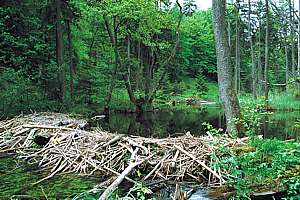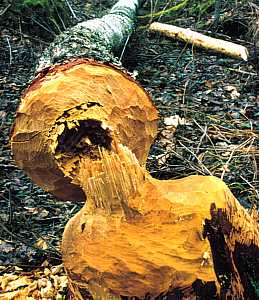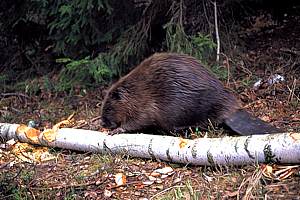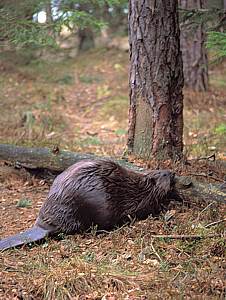|
BEAVERS
|
||||||||||
Text:
|
Beaver's impact on environment
Beavers strongly influence the environment that they live in. By building dams on watercourses, they raise the surface water level which is thought to be the most important effect of their presence in the area inhabited by man. The animals usually settle down near the rivers with relatively easy fall. These are usually shallow and narrow rivers with a variable water level. When building a dam, beavers ram the large logs into the river bottom. Then they cross them with horizontally placed branches, which makes a construction that is easy to seal using mud, plant fragments and turf. Another layer of crosswise branches and sealing material is then applied, and the whole procedure is repeated until the dam is finished. The chosen material is transported onto the top of the dam and carefully placed where the water pours over. During the dam erection the animals float the material down the current. The water carries the animal on top, downwards the watercourse, making it easy to place mud and branches on top of the dam.
Dam building increases the volume of water in beaver ponds. The reason for maintaining the proper water depth is covering the entrances to the dens, at the same time enabling freedom of swimming, diving, and material transportation. The floodings created as a result of water damming provide easier access to the distant food base. A newly created pond also provides security, as the beaver, which is a poor walker on the ground, always escapes to the water in case of emergency. These are some of the reasons for which beaver family members keep trying to maintain a few, up to over ten, dams on the longest possible river sequence. As a result of such actions the water flow is slowed down. When a couple of families settle down along one river, the sizes of water rises are smaller, and the watercourse becomes more natural.
The consequences of such a situation are very important for the river ecosystem and the terresial environments that surround it. New plant clusters develop on the flooded river shores. The process of restoring natural alder and river carrs or willow scrubs (łozowiska) is begun. Rich vegetation and diverse fauna complexes develop within the transition zones (ecotones), on the shores of the newly created ponds. Shallow, easily warming water creates excellent conditions for the creation of the complexes of wetland vegetation. Soon after creation, the pond becomes overgrown by aquatic vegetation, and sedges, reeds and other rush-plants develop on the shores. A wide, swampy transition zone is also created between the water and the land. The flooded tree stands loose their productive function, but high increment of high quality tree volume is recorded within some distance from the water. As a result of timber gnawing the forest floor becomes more sun-heated, which initiates rapid growth of underbush, ground cover and herbaceous vegetation. Although in terms of forest economy some timber losses are reported, the general increase of plant biomass resulting from increased sun-heating is greater than timber mass decrease caused by gnawing.
A very important effect of the presence is self purification of the water in beaver ponds. The fine sediments and organic substances that fall on the bottom create a perfect substratum for the development of aquatic vegetation. Thanks to the development of vegetation, the river bed is stabilised and the newly created complex not only catches the sediments, but also acts like a filter and a container of sediments inflowing from the surrounding ecosystems. As a result of the accumulation of organic substances, water micro-organisms maintain high metabolic activity. The chemistry and hydration of the soils changes. The pollutants flowing into the pond can be decomposed by micro-organisms, and the majority acids and alkalis carried in by the water is neutralised. The pond plays a role of a treatment plant by acting like a biological decanter and a filter. The dam itself, thanks to its compact construction, also works like a macro-filter that stops the contaminants carried by the water current. The stopped material holds the water for a longer period of time, thus creating more favourable moisture conditions around the pond.
Beaver ponds located along the river increase the general water retention in the drainage basin. It is particularly important during the spring bank overflows. The surface water that flows over the dam spreads on a larger area, which slows down the speed of the water flow. The beaver ponds, having some ability of water accumulation, flatten the top of the flood-wave. The flood-wave loses its momentum by being distributed over the large areas of consecutive ponds. The consequence of such phenomenon is the weakening of the destructive processes of river-bed erosion.
The activity of beavers within the boundaries of their area may start the process of re-naturalization of watercourse artificially regulated by man. Digging dens and canals, as well as creating floodings, initiate the natural swampy processes. As a result of dens wash-out and collapsing, numerous meanders and shallow waters are created, which are then overgrown by aquatic vegetation and rush-plants. The meanders and shallow waters that form in the littoral zone change the original character and shape of the shoreline. The slow current areas are the places where organic sediments inhabited by numerous invertebrates accumulate. The dams, on the other hand, trigger the stabilisation of ground waters in the area surrounding the watercourse. The area of abundant vegetation and animal world is restored.
The water bodies created by beavers are conductive to water temperature raise during summer, which facilitates the growth of plant and animal plankton. The accumulation of organic matter and the slowing down of water flow are conductive to the growth of many species of water invertebrates, such as common mayflies, caddis-flies and dipterans. These are then the food for many species of fish, amphibians, reptiles and birds. The abundance of fish causes the beaver's habitat to be eagerly inhabited by otter, mink, grey heron, black stork and other ichtyophagous animal species. The presence of small islands, dead trees and other naturally created shelters creates favourable nesting conditions for many bird species. The difficult to reach ecosystem of a beaver pond provides shelter and food for many populations of small mammals. The floodings are willingly visited by mooses, deer and wild hogs. As a result, the beaver ponds play an important role in increasing the natural diversity in the whole complex of ecosystems.
From the ecological point of view, the presence of beavers in the environment and the effects of their activity are positive. The way of settling and living, as well as feeding selectivity of this species significantly influence the course of the natural transformation of ecosystems (ecological succession). Sadly, in terms of forest and agricultural production, the beavers' impact on their surroundings (trees gnawing, flooding the green crops) is negative. Although the character of environmental changes triggered by beavers is always similar, its evaluation may be very different, depending on the way this problem is judged.
|
|||||||||
|
|
|



